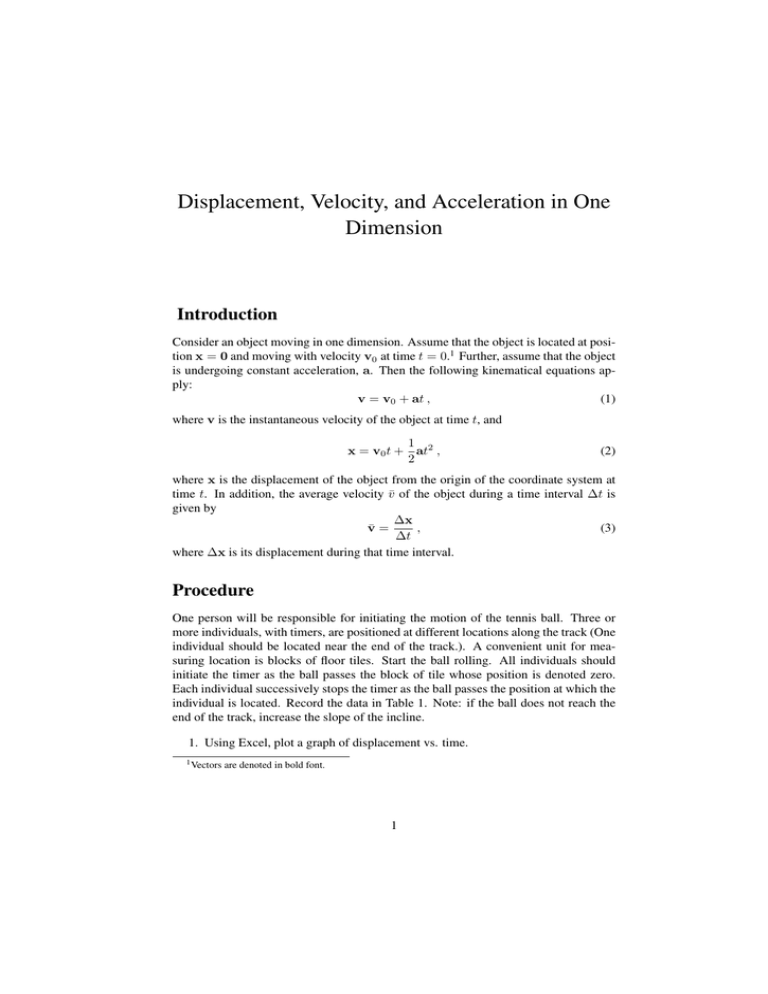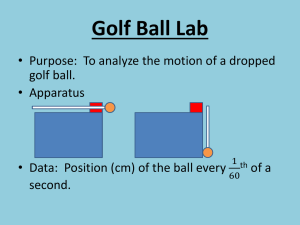Displacement, Velocity, and Acceleration in One Dimension
advertisement

Displacement, Velocity, and Acceleration in One Dimension Introduction Consider an object moving in one dimension. Assume that the object is located at position x = 0 and moving with velocity v0 at time t = 0.1 Further, assume that the object is undergoing constant acceleration, a. Then the following kinematical equations apply: v = v0 + at , (1) where v is the instantaneous velocity of the object at time t, and 1 x = v0 t + at2 , 2 (2) where x is the displacement of the object from the origin of the coordinate system at time t. In addition, the average velocity v̄ of the object during a time interval ∆t is given by ∆x v̄ = , (3) ∆t where ∆x is its displacement during that time interval. Procedure One person will be responsible for initiating the motion of the tennis ball. Three or more individuals, with timers, are positioned at different locations along the track (One individual should be located near the end of the track.). A convenient unit for measuring location is blocks of floor tiles. Start the ball rolling. All individuals should initiate the timer as the ball passes the block of tile whose position is denoted zero. Each individual successively stops the timer as the ball passes the position at which the individual is located. Record the data in Table 1. Note: if the ball does not reach the end of the track, increase the slope of the incline. 1. Using Excel, plot a graph of displacement vs. time. 1 Vectors are denoted in bold font. 1 Figure 1: Equipment 2. Assume the ball has undergone constant acceleration. Perform a polynomial regression of degree two, requiring the intercept to be zero. Report parameters estimated for the polynomial and the value of R2 . Based on the value of R2 do the data support the hypothesis that the ball has undergone constant acceleration? 3. Compare the regression equation of part two to Eq. 2 and estimate the acceleration of the ball and its initial speed. Is the acceleration positive or negative? What is the significance of the sign? Whenever the sign of the acceleration is negative, does this always imply deceleration? 4. Substitute the values of the initial velocity and acceleration estimated by regression into Eq. 1 to obtain an explicit expression for the instantaneous velocity as a function of time. 5. Using the equation derived in part 4, calculate the instantaneous velocity of the ball at the end of the run, i.e. at the time recorded when the ball has reached the end of the track. 6. Calculate the average velocity of the ball for the entire trip using Eq. 3. 7. Does the instantaneous velocity at the end of the trip equal the average velocity for the trip? Should these two quantities be equal if the ball is undergoing constant acceleration? Explain. 2 t (s) x (blocks) 1 2 3 4 5 6 7 Table 1: Time and Displacement Data 3




